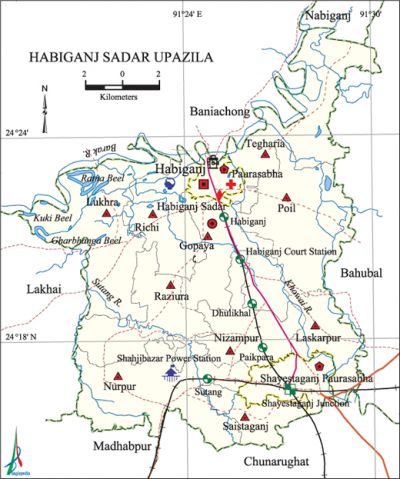Habiganj Sadar Upazila
Habiganj Sadar Upazila (habiganj district) area 253.74 sq km, located in between 24°15' and 24°27' north latitudes and in between 91°19' and 91'30' east longitudes. It is bounded by baniachang and nabiganj upazilas on the north, chunarughat and madhabpur upazilas on the south, bahubal upazila on the east, lakhai upazila on the west.
Population Total 275074; male 140951, female 134123; Muslim 244965, Hindu 29701, Buddhist 90, Christian 89 and others 229.
Water bodies Main rivers: barak, khowai and Sutang; Ratna Beel, Gharbhanga Beel and Kuki Beel are notable.
Administration Habiganj Thana was formed in 1893 and it was turned into an upazila in 1984.
| Upazila | ||||||||
| Municipality | Union | Mouza | Village | Population | Density (per sq km) | Literacy rate (%) | ||
| Urban | Rural | Urban | Rural | |||||
|
2 |
10 |
157 |
246 |
84276 |
190798 |
1084 |
63.09 |
39.47 |
| Municipality (Habiganj) | ||||||||
|
Area |
Ward |
Mahalla |
Population |
Density |
Literacy rate | |||
|
7.11 |
9 |
63 |
55476 |
7803 |
- | |||
| Municipality (Shayestaganj) | ||||||||
|
Area |
Ward |
Mahalla |
Population |
Density |
Literacy rate | |||
|
12.77 |
9 |
29 |
18165 |
1412 |
- | |||
| Upazila Town | ||||||||
|
Area |
Mouza |
Population |
Density |
Literacy rate | ||||
|
6.98 |
2 |
10635 |
1524 |
- | ||||
| Union | ||||
| Name of union and GO code | Area (acre) | Population | Literacy rate (%) | |
| Male | Female | |||
|
Gopaya 22 |
6114 |
11436 |
11253 |
43.05 |
|
Tegharia 95 |
6848 |
7749 |
7316 |
31.81 |
|
Nizampur 38 |
3237 |
10174 |
9612 |
51.09 |
|
Nurpur 47 |
7382 |
12639 |
12595 |
44.00 |
|
Poil 57 |
10104 |
9584 |
9294 |
38.99 |
|
Raziura 66 |
5571 |
10240 |
10103 |
29.04 |
|
Richi 76 |
4856 |
12674 |
12042 |
36.22 |
|
Laskarpur 24 |
3800 |
10936 |
10674 |
44.54 |
|
Lukhra 28 |
7513 |
11280 |
10684 |
29.33 |
|
Shayestaganj 85 |
4931 |
5729 |
5419 |
48.41 |
Source Bangladesh Population Census 2001,Bangladesh Bureau of Statistics.

Archaeological heritage and relics Shankar Pasha Mosque at Uchail (1513 AD).
Religious institutions Mosque 213, temple 17, tomb 13, church 1. Noted religious institutions: Shankar Pasha Mosque at Uchail, Daudnagar Mosque, Machhulia Akhra.
Literacy rate and educational institutions Average literacy 47.04%; male 51.38%, female 42.54%. Educational institutions: college 4, primary teachers training institute 1, technical college 1, secondary school 20, primary school 146, kindergarten 2, madrasa 16. Noted educational institutions: Habiganj Government Bindaban College, Habiganj Government High School (1843), Fakirabad Government High School (1890), Habiganj High School (1913), Shayestaganj High School (1918), BKGC Government Girls' High School (1923), GK and HK High School (1924), Laskarpur Primary School (1843), Habiganj Government Primary School (1883), Nizampur Dakhil Madrasa (1935), Shayestaganj Kamil Madrasa, Habiganj Daruchchhunnat Senior Madrasa.
Newspapers and periodicals Daily: Swadesh Barta, Khowai, Habiganj Samachar, Pravakar, Pratidener Bani, Ajker Habiganj; weekly: Janatar Dalil.
Cultural organisations Library 7, club 65, Shilpakala Academy 1, music academy 1, auditorium 3, theatre stage 1, theatre group 5, jatra party 1, literary organisation 3, cultural organisation 5, cinema hall 3, community centre 2, playground 7, women organisation 5.
Tourist spots Sultanshi build by the great poet Syed Sultan, ancient dighi of Syed Gaous (R) at Mashajan.
Main sources of income Agriculture 47.13%, non-agricultural labourer 5.72%, commerce 16.79%, transport and communication 4.78%, service 8.74%, construction 2.11%, religious service 0.35%, rent and remittance 2.25% and others 12.13%.
Ownership of agricultural land Landowner 55.68%, landless 44.32%; agricultural landowner: urban 48.16% and rural 58.78%.
Main crops Paddy, wheat, sugarcane, potato, jute, pumpkin, peanut, vegetables.
Extinct or nearly extinct crops Kaun, sesame, linseed.
Main fruits Mango, jackfruit, banana, litchi, blackberry.
Fisheries, dairies and poultries Fishery 600, dairy 40, poultry 112, hatchery 11.
Communication facilities Pucca road 74 km, semi-pucca road 43 km, mud road 96 km; railway 27 km; waterway 30 nautical miles.
Extinct or nearly extinct traditional transport Palanquin, soari, bullock cart.
Noted manufactories Biscuit factory, chira (threshed rice) mill, rice mill, saw mill.
Cottage industries Goldsmith, blacksmith, potteries, bamboo and wood work.
Hats, bazars and fairs Hats and bazars are 25, fairs 3, most noted of which are Chowdhury Bazar, Katiadi Bazar, Daudnagar Bazar and Shahibazar and Kalibari Mela.
Main exports Paddy, rice, sugarcane molasses.
Access to electricity All the wards and unions of the upazila are under rural electrification network. However 42.93% of the dwelling households have access to electricity.
Natural resources Jalalabad Gas Field.
Sources of drinking water Tube-well 89.09%, pond 2.63%, tap 4.42% and others 3.86%.
Sanitation 46.22% (rural 36.78% and urban 69.10%) of dwelling households of the upazila use sanitary latrines and 48.26% (rural 56.92% and urban 27.12%) of dwelling households use non-sanitary latrines; 5.52% of households do not have latrine facilities.
Health centres Hospital 1, Upazila health complex 2, family planning centre 2, Union health and family welfare centre 7, maternity and child welfare centre 1, clinic 3, satellite clinic 3, diagnostic centre 3.
NGO activities Operationally important NGOs are CARE, brac, asa, Vision. [Md Kabir Hussain]
References Bangladesh Population Census 2001, Bangladesh Bureau of Statistics; Cultural survey report of Habiganj Sadar Upazila 2007.
